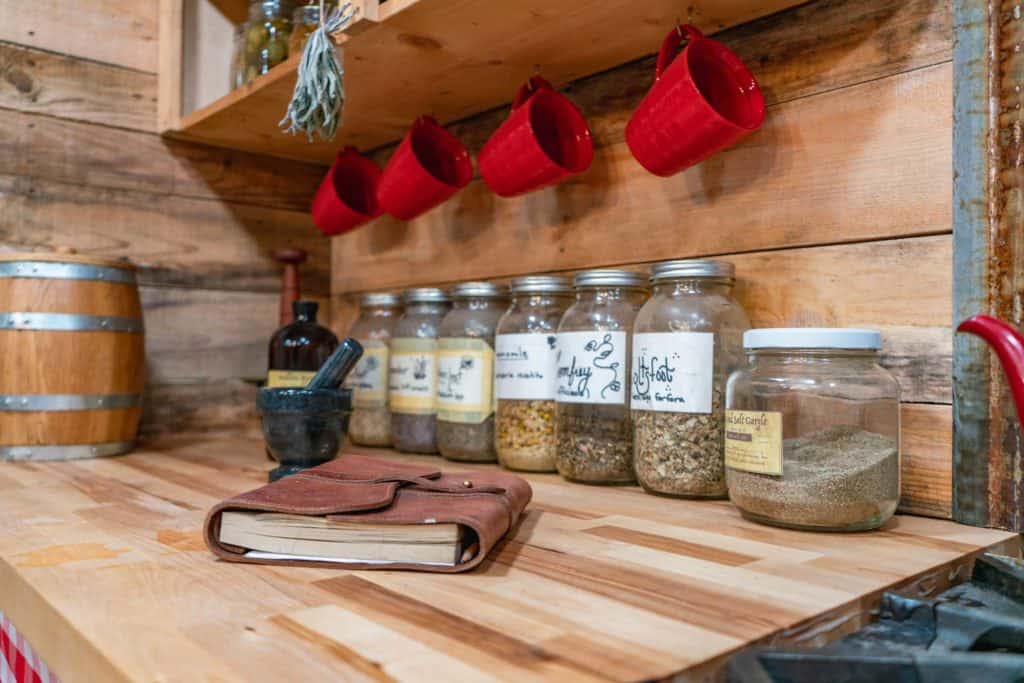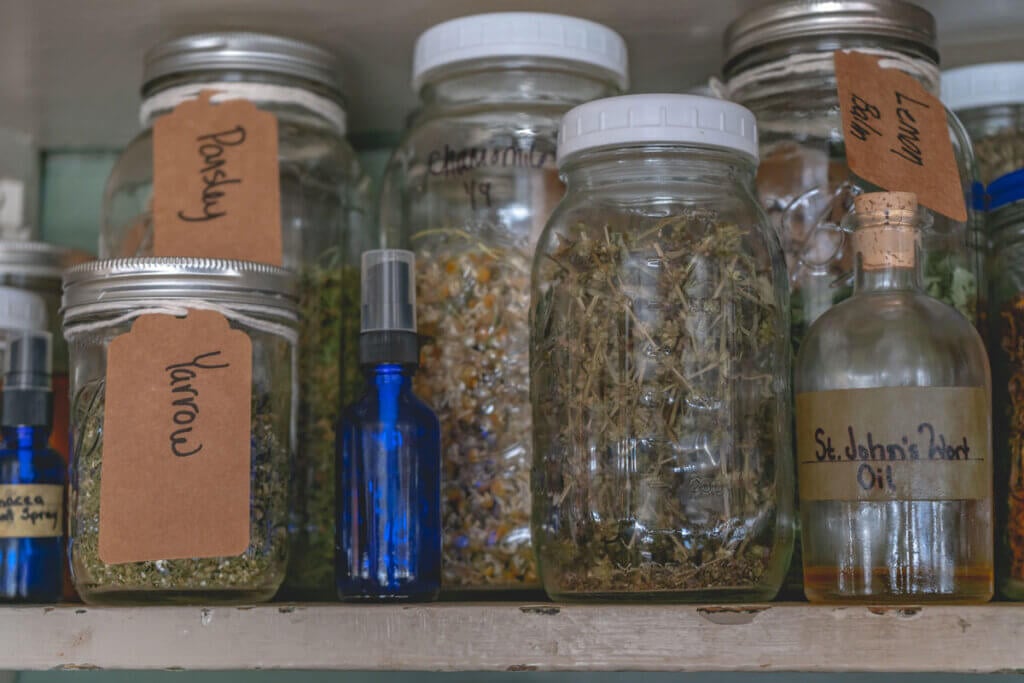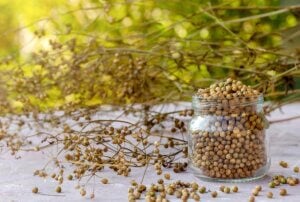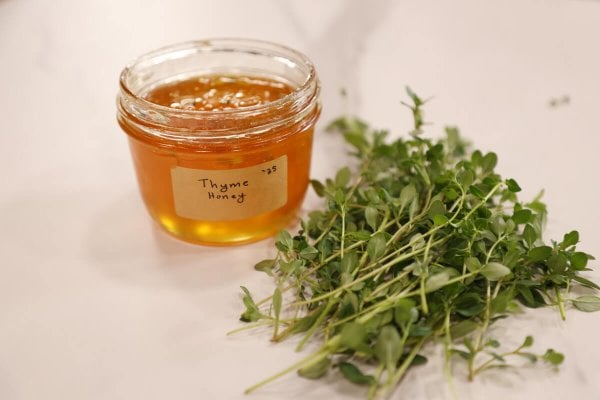If you’re looking to cultivate a thriving cottage garden, you’ve come to the right place. Sage, with its aromatic leaves and versatile uses, is a wonderful addition to any herb garden. Use this guide for essential tips and advice to help you successfully grow and care for sage plants, so they thrive and provide you with bountiful harvests.

Table of Contents
ToggleWhy I Love Growing Sage
Growing an old-fashioned cottage garden and practicing herbalism are things I’m passionate about, and I have spent years educating myself about medicinal herbs and their uses.
Due to its versatility and powerful medicinal properties, sage is among my favorite 15 medicinal herbs to grow, along with calendula, valerian, horseradish, and yarrow.
Learning how to use herbal medicine safely at home for my family’s health and using them on our farm animals has been instrumental in going off-grid with our healthcare and increasing our self-sufficiency.
How to start using medicinal herbs can seem daunting, but it has proved worth the effort to learn how to naturally and safely treat common ailments and support immune-building health.
It’s important to note that I am not a certified medical practitioner. This post is not intended to diagnose or treat but is for informational purposes only. Please contact your medical care professional before introducing new herbal remedies into your wellness routine.

Varieties of Sage
When it comes to choosing the right sage for your herb garden, there are several interesting varieties to consider. Each variety offers its own unique characteristics and flavors. Let’s explore some popular varieties of sage:
| Variety | Characteristics |
|---|---|
| Salvia Officinalis | This classic variety of sage, also known as common sage, garden sage or culinary sage is widely recognized for its strong aroma and bold flavor. Its gray-green leaves add a touch of elegance to seasoning meats, soups, and sauces. |
| Purple Sage | With beautiful purple-colored leaves, this variety of sage not only adds visual appeal to your garden but also imparts a milder flavor compared to common sage. It’s a great choice for culinary creations. |
| Tricolor Sage | If you’re looking to add a pop of color to your herb garden, tricolor sage is perfect. Its leaves feature a splendid mix of green, white, and purple, creating a visually stunning addition to dishes. |
| Pineapple Sage | Known for its fruity scent reminiscent of pineapple, this variety of sage adds a delightful twist to your culinary endeavors. Its vibrant red flowers (pictured above) attract pollinators, making it a favorite among gardeners. |
| White Sage | White sage is not only renowned for its culinary applications but also holds cultural and spiritual significance to the Native Americans. It is often used in smudging rituals. |

Benefits of Growing Sage
Sage is a versatile and aromatic herb providing numerous benefits to your home garden, recipes, and health. Its delightful fragrance and culinary uses make it a cherished addition to my cottage garden.
How Sage Benefits the Garden
Whether you’re a seasoned gardener or a beginner, I highly recommend adding sage to your home garden.
- Practicality – Sage is a perennial herb that grows easily and requires minimal maintenance. Once established, it provides a consistent harvest season after season.
- Aromatic Delight – The distinct scent of sage is truly captivating. Whether it lingers on my hands after harvesting or fills the air as I brush past the plant, the aroma serves as a gentle reminder of the rewards of cultivating nature.
- Garden Companionship – Companion planting is a wonderful natural method to deter pests and encourage other plants to proliferate. Sage is known to deter cabbage moths, carrot flies, and flea beetles, and when allowed to flower, sage can also attract beneficial pollinators.

Culinary Benefits of Sage
Sage, with its distinct flavor and aroma, is a versatile herb that can take your cooking to new heights. Whether you’re preparing savory dishes or experimenting with desserts, sage adds a unique touch that sets your recipes apart. Let’s explore the culinary uses of sage and discover how this herb can elevate your cooking.
- Sage in Savory Dishes – When it comes to savory dishes, sage is a wonderful addition that brings depth and complexity to the flavors. Its earthy and slightly peppery taste pairs well with meats, poultry, and fish, adding a delicious herbal undertone. In Italian cuisine, sage is often used in classic dishes like Saltimbocca and Risotto. Try using fresh sage leaves to infuse your sauces and stews with its aromatic essence.
- Sage in Soups and Stuffings – Sage shines in hearty soups and comforting winter dishes. The warm and cozy aroma of sage leaves enhances the flavors of butternut squash, pumpkin, and sweet potato soups. It’s also a key ingredient in Thanksgiving stuffings, where its earthiness complements the rich flavors of bread, herbs, and vegetables.
- Sage in Pasta and Risotto – When making pasta or risotto, sage can provide a delicious herbal twist. Try sautéing fresh sage leaves in butter or olive oil and drizzling the fragrant mixture over your cooked pasta or risotto. The crispy sage leaves add a delightful texture, while the flavorful oil infuses the dish with a savory taste.
- Sage in Desserts – Yes, you read that right! Sage can also be used in desserts to create unique and unexpected flavors. Its earthy notes pair beautifully with citrus fruits, such as lemon or orange. Try adding chopped sage leaves to your shortbread cookies or infusing the buttercream frosting with a hint of sage. You could also make sage ice cream with this homemade vanilla ice cream as the base. The result is a delightful balance of sweet and herbal flavors that will surprise and delight your taste buds.

Sage Health Benefits
When it comes to the health benefits of sage, this aromatic herb offers more than just great flavor. Sage has long been recognized for its medicinal properties and its ability to contribute to overall well-being. From soothing digestive issues to promoting oral health, sage has a lot to offer in terms of supporting a healthy lifestyle:
- Digestive Health – Sage has traditionally been used to address various digestive ailments, including indigestion, bloating, diarrhea and stomach cramps. Its natural compounds can help ease discomfort and support healthy digestion. (Source)
- Oral Health – The antibacterial properties of sage make it a beneficial herb for promoting oral health. It can help to combat bad breath, reduce inflammation in the gums, and even assist in treating sore throats. Incorporating sage into your oral care routine can contribute to a healthier smile and fresher breath. (Source)
- Cognitive Function – Recent studies have suggested that sage may have positive effects on cognitive function and memory. The compounds found in sage have been shown to enhance brain health and may help to improve focus, concentration, and overall mental clarity. (Source)
- Anti-Inflammatory Properties – Sage contains powerful antioxidants that can help reduce inflammation in the body. This makes it a valuable herb for individuals dealing with conditions like arthritis, asthma, or other inflammatory diseases. (Source)
- Reducing Menopausal Symptoms – Sage has been found to be effective in reducing menopausal symptoms, such as hot flashes and night sweats. The estrogen-like compounds found in sage can help regulate hormone levels and alleviate the discomfort associated with menopause. It can be consumed as a tea or incorporated into meals for maximum benefit. (Source)

Growing Sage
By using these techniques for growing sage, you can cultivate a robust sage plant to produce for years to come.
Planting
Properly planting sage is the first crucial step for successful growth and development in your herb garden.
- Sun – Find a sunny spot in your garden where the sage will receive at least 6-8 hours of direct sunlight each day.
- Soil – Sage grows best in well-draining soil with a pH level between 6.0 and 7.0. You can test your soil’s pH before planting for the best results. If needed, amend the soil with organic matter, such as compost, to improve its fertility and drainage.
- Seeds – You can start your seeds indoors and learn when to pot up seedlings before planting them in the ground. If you plant directly into the soil, do so after all signs of frost have passed. The ideal soil temperature for germination is 65°F-70°F. Whether planting indoors or direct sowing, sow the seeds ¼ inch deep and keep them moist until germination, usually between 10-20 days. Sage is also a great option for growing in pots (learn how to winterize your plants in pots here).
- Seedlings – When transplanting seedlings, dig a hole that is slightly larger than the sage plant’s root ball. Place the plant in the hole and backfill it with the soil, gently patting it down to ensure good soil-to-root contact. After planting, water the sage thoroughly to settle the soil around the roots. Be careful not to overwater, as sage prefers slightly dry conditions.
- Spacing – Sage plants should be spaced approximately 12-18 inches apart to allow for proper airflow and prevent overcrowding. This spacing also gives the plants room to grow and expand.
- Mulching – Applying a layer of organic mulch around the base of the plants helps to retain moisture, suppress weed growth, and regulate soil temperature.
- Companion Planting – Sage will deter pests and attract pollinators; planting near brassicas, tomatoes, strawberries, and rosemary makes it a good companion.

Growing
When it comes to growing sage, following a few key tips can make all the difference to make sure your plants thrive. From providing good air circulation to maintaining well-drained soil, these essential growing tips will help you cultivate healthy sage plants.
- Watering – While sage is drought-tolerant once established, it’s important to water newly planted sage regularly until it becomes established. Water deeply, allowing the soil to dry slightly between waterings. Avoid overwatering, as sage plants are susceptible to root rot in waterlogged conditions. Homesteading Hack: You can check out our garden watering strategies for more tips on properly watering a garden.
- Pruning – Regular pruning not only helps shape your sage plants but also encourages bushier growth and better air circulation. Trim back any leggy or straggly growth to promote denser foliage. Prune your sage plants in late spring or early summer, after the first flush of flowers, to maintain their shape and encourage more compact growth.
- Fertilizing – Once every four to six weeks, add some compost tea from homemade compost. This will help to keep the soil from being depleted.

How to Harvest Sage
By harvesting sage at the right time and handling the leaves with care, you can enjoy a plentiful yield of flavorful sage for your culinary adventures.
Homesteading Hack: After harvesting, it’s important to handle the sage leaves with care to preserve their freshness and flavor. Avoid bruising or crushing the leaves excessively, as this can result in a loss of essential oils and aroma.
- Timing – When sage plants are mature and have developed strong, healthy leaves, it’s time to begin the harvesting process. Ideally, wait until early morning or late afternoon to avoid the heat of the day, as this can cause the sage leaves to wilt.
- Pruning – Carefully inspect your sage plant and identify the branches or leaves you wish to harvest. Using a pair of sharp, clean pruning shears or scissors, cut the branches or leaves as close to the base as possible. Avoid removing more than a third of the plant’s foliage at once, as this can hinder its growth and overall health.
- Storing – There are a few different methods to choose from when storing sage.
- Fresh Use – If you’re harvesting sage for immediate use, rinse the leaves under cool water to remove any dirt or debris. Pat them dry gently with a clean towel or paper towel before incorporating them into your recipes.
- Long-Term Storage – If you’re harvesting sage leaves for long-term storage, you can either preserve herbs in salt, dry herbs, freeze herbs, or freeze-dry herbs. Whichever method you choose, always remember to store your finished product away from light and humidity.

Overwintering Sage
Sage, a perennial herb, requires special care during the winter months to promote its survival and longevity. By implementing the right techniques, you can protect your sage plants from frost and cold temperatures, allowing them to thrive year after year.
- Preparing Sage to Overwinter in the Ground – Before the onset of frost, it’s important to prepare your sage plants for the winter months. Follow these steps to help your sage survive the cold:
- Trim – Gently prune your sage plant, removing any dead or damaged foliage. This helps promote air circulation and prevents disease.
- Clean – Clear away any fallen leaves or debris around the base of the plant. This prevents pests and diseases from establishing themselves during the winter.
- Light Mulching – Apply a light layer of mulch around the base of the sage plant. This helps insulate the roots and retain moisture without smothering the plant.
- Choosing an Overwintering Location – If you don’t think your sage will overwinter in the ground where you have planted it, there are some options. When deciding where to overwinter your sage plants, consider the following factors:
- Temperature – Choose a location that remains consistently cool but not freezing, such as an unheated garage or a cold frame.
- Light – Make sure there is enough natural light for the sage plants to continue photosynthesizing. A sunny windowsill or a greenhouse with adequate light is ideal.
- Air Circulation – Good air circulation helps prevent diseases. Avoid placing the sage plants in an area with stagnant air.
- Winter Care – Now that you have prepared your plants and chosen a location, it’s time to overwinter your sage.
- Container Plants – If your sage is grown in containers, bring them indoors before the first frost. Place them in the chosen overwintering location.
- In-Ground Plants – For sage plants grown directly in the ground, dig up the root ball carefully, ensuring you don’t damage the plant. Transfer the plant to a larger pot or container with well-draining soil.
- Watering – During the winter months, water your sage plants sparingly (only when the soil feels dry to the touch.) The goal is to keep the soil slightly moist but not wet, as too much moisture can lead to root rot.
- Provide Ventilation – If your sage plants are indoors, crack a window or door periodically to allow fresh air to circulate.
- Additional Light – If your sage plants aren’t getting enough natural light, supplement with a grow light to ensure they receive adequate illumination.
- Bringing Sage Out of Winter Dormancy – When spring arrives and the threat of frost has passed, it’s time to bring your overwintered sage plants out of their dormant state.
- Gradual Transition – Begin by placing the sage plants in a partially shaded area for a few hours each day. After a week, gradually increase their exposure to direct sunlight.
- Replanting – If your sage plants were potted for overwintering, replant them in their permanent location after the danger of frost has passed. Prepare the soil by amending it with organic matter for optimal growth.
- Regular Care – Once your sage plants are fully acclimated to their outdoor environment, resume regular care practices, including watering, fertilizing, and pruning as needed.

Using Herbal Medicine
With its delightful aroma and distinct flavor, sage is a beneficial addition to your garden, adds a unique touch to any culinary creation, and even stocks your herbal medicine cabinet.
If you are ready to learn more about multi-purpose herbs that can heal your family naturally, the Herbal Medicine Cabinet: Colds and Flu class is designed just for you. When you sign up, you will receive answers to questions like…
- Which herbs are you supposed to use for various illnesses?
- Where do you find the best quality herbal medicines?
- Are all herbs safe to treat your family with?
- And so much more!
This masterclass has been recently updated to include flu and flu-like viruses. This simple system will allow you to stock your herbal medicine cabinet confidently, using simple herbs to safely, naturally and effectively treat your family this cold and flu season.

FAQ
To plant sage, choose a location with full sun and well-draining soil. Dig a hole twice the size of the root ball, place the sage plant in the hole, and backfill with soil. Water the plant thoroughly after planting and regularly thereafter.
Sage plants should be watered deeply once a week. However, it is important to ensure that the soil is not overly saturated or waterlogged, as this can lead to root rot. Good air circulation and well-drained soil are key to preventing moisture-related issues.
Yes, sage can be grown indoors. Choose a container with good drainage and fill it with well-draining potting soil. Plant the sage seed or young plant at a depth of approximately ¼ to ½ inch of soil. Place the pot in a sunny location and water the plant regularly, allowing the soil to dry slightly between waterings.
There are various types of sage to choose from, including the classic Salvia Officinalis with its gray-green leaves, tricolor sage with its variegated foliage, and Russian sage with its feathery silver-gray leaves. Each variety has its own unique characteristics and visual appeal.
The height of sage plants can vary depending on the variety and growing conditions. On average, sage plants can grow to be about 12 to 24 inches tall, but certain varieties, such as Russian sage, can reach heights of up to 3 to 4 feet.



















